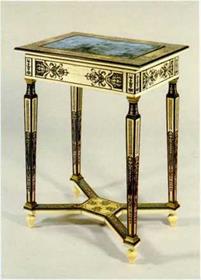In 1663 Gole completed two sumptuous cabinets ordered by Mazarin in his will as a present worthy of the King, and which give the measure of Gole’s reputation. These cabinets, designed in ebony and gilt bronze, after drawings by Le Brun, incorporated five niches with allegorical figures separated by columns of polychrome marble, and surmounted by a balustrade. The base of each was composed of twelve caryatids in gilded wood symbolizing the months of the year. Identified by M. Scheurleer in the Cluny Museum, these caryatids are very similar to the stucco terms designed at the same period by Le Brun for the Oval Salon at Vaux-le-Vicomte and the Ambassadors’ Staircase at Versailles.
Cole’s most important royal commission remains that of two large ‘cabinets dc la Guerre et dc la Paix’ executed between 1665 and 1668 and for which payments continued at intervals up to 1678, amounting to 25.800 livres. These cabinets have disappeared, as have those of Mazarin and many others belonging to Louis XIV. probably broken up in the middle of the eighteenth century by dealers or £benistes who would have bought them from the Crown (there were four sales of Louis XIV’s cabinets in 1741. 1751 and 1752) in order to retrieve the precious materials with which they were embellished. However, the appearance of Cole’s cabinets is preserved for us in an engraving in the Kunstbibliothek in Berlin. They resembled triumphal arches with central and incurving sides on a base formed by caryatids. Veneered in ebony, they were decorated with small panels of brass and pewter, and in particular miniature pictures on copper flanked by columns of lapis lazuli. This raises the question of Cole’s collaboration with the workshops at the Gobelins where the King’s cabinets were being assembled – mainly under Cucci, following designs by Le Brun. There is no mention in the records of any links between Cole and the Gobelins, while it is known that he had his workshop at the junction of the rue de I’Arbre – Sec. in that elegant quarter close to the Louvre. Nevertheless. it is very likely that Cole did work periodically on the important royal commissions at the Gobelins, maintaining another workshop in Paris for his private clientele. The famous tapestry recording the King’s visit to the Gobelins in 1667 (6) depicts at least two cbenistes. one of whom is clearly Cucci. while the other must be Cole, presenting a table with tortoiseshell marquetry (the type of furniture for which he was favoured with commissions by the Crown). In addition. the inventory drawn up after his death in 1684 mentions the sum of 659 livres ‘owed to Sr Huze.
|
)2) Table c. 1674. in пюгу and Porcelaine. ij. Paul Getty blue-stained horn, probably Museum, Malibu. California I produced for the Trianon de |
brewer at the Gobelins… for beer supplied by him’, which can only imply that Cole had a team of craftsmen working under his direction at the Gobelins.




